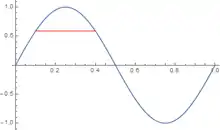
In mathematical analysis, the universal chord theorem states that if a function f is continuous on [a,b] and satisfies , then for every natural number , there exists some such that .[1]
History
The theorem was published by Paul Lévy in 1934 as a generalization of Rolle's Theorem.[2]
Statement of the theorem
Let denote the chord set of the function f. If f is a continuous function and , then for all natural numbers n. [3]
Case of n = 2
The case when n = 2 can be considered an application of the Borsuk–Ulam theorem to the real line. It says that if is continuous on some interval with the condition that , then there exists some such that .
In less generality, if is continuous and , then there exists that satisfies .
Proof of n = 2
Consider the function defined by . Being the sum of two continuous functions, is continuous, . It follows that and by applying the intermediate value theorem, there exists such that , so that . Which concludes the proof of the theorem for
Proof of general case
The proof of the theorem in the general case is very similar to the proof for Let be a non negative integer, and consider the function defined by . Being the sum of two continuous functions, is continuous. Furthermore, . It follows that there exists integers such that The intermediate value theorems gives us c such that and the theorem follows.
See also
References
- ↑ Rosenbaum, J. T. (May, 1971) The American Mathematical Monthly, Vol. 78, No. 5, pp. 509–513
- ↑ Paul Levy, "Sur une Généralisation du Théorème de Rolle", C. R. Acad. Sci., Paris, 198 (1934) 424–425.
- ↑ Oxtoby, J.C. (May 1978). "Horizontal Chord Theorems". The American Mathematical Monthly. 79: 468–475. doi:10.2307/2317564.